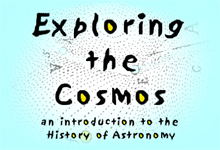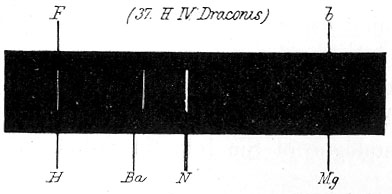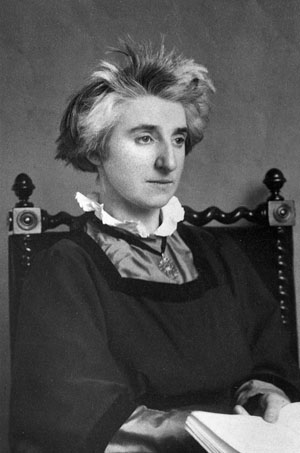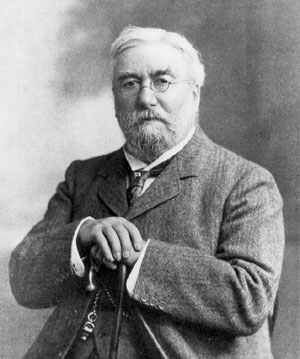

Department of History
University of California, Irvine
Instructor: Dr. Barbara J. Becker
![]()
Lecture 14. The Riddle of the Nebulae.
![]()
A Region Hitherto Unexplored |
||||||||
In his 1897 retrospective essay, "The New Astronomy", William Huggins tells us: "I was fortunate in the early autumn of ... 1864, to begin some observations in a region hitherto unexplored" namely, the nebulae. He could indeed feel "fortunate" to have turned his spectroscope on this class of celestial objects. They are among the faintest on the sky. Although it had been over thirty years since he caught his first glimpse of a nebula's spectrum, he recounted the experience in riveting detail as if it were only yesterday. There is nothing in Huggins's notebooks, correspondence or published papers to bridge his abrupt shift in attention from common terrestrial elements and stellar spectra to the unresolved nebulae. Whatever encouraged him to subject their light to spectroscopic scrutiny, it was a bold stroke which ultimately propelled him to a position of prestige and authority within the wider science community. The results of his investigation captured his colleagues' imagination and heightened their awareness of the potential of prismatic analysis to generate new knowledge of the heavens. Over the years, as the new path he opened up became a well-worn thoroughfare, the public -- probably even Huggins himself -- lost sight and memory of the research options he and his colleagues had available to them in August 1864. Historians have relied on his retrospective essay. Its endearing simplicity and firsthand authority established Huggins's decision as less a choice than an inevitable next step in the advance of scientific knowledge. But this account has been allowed to stifle curiosity for too long. It is time to turn back the clock, albeit imperfectly, to the summer of 1864, to situate Huggins more authentically within the prevailing climate of interest that prompted him to tackle what he later called the "riddle of the nebulae". |
||||||||
Astronomical Questions: Summer 1864 |
||||||||
Without unfiltered first person documentation, we lack the palette necessary to paint a faithful portrait of William Huggins as he stood on the verge of his landmark discovery in the summer of 1864. Fortunately there is ample ink available in the public record to bring the man and his motives into relief against the busy background of the astronomical community at large. To fill our pen, we turn first to the February 1864 number of the Monthly Notices of the Royal Astronomical Society for a review of the past year's notable developments. Important advances had been made on key, albeit workaday, problems like solar parallax. But, there was no mention of nebulae. In truth, there had been little new to say about nebulae since the landmark observations of William Parsons, 3rd Earl of Rosse. In 1850, after examining numerous nebulae with his unparalleled 6-ft reflector, Lord Rosse despaired "the subject has become ... more mysterious and more inapproachable". Given the physical limits of instrumentation and atmospheric distortion, it seemed to him that the debate over nebulae would remain unanswerable in any positive, testable way.
M51 (Whirpool), drawing by Lord Rosse Even the chapter on "Clusters of Stars and Nebulae" in the latest edition of John Herschel's authoritative Outlines of Astronomy remained exactly as it appeared when it was first published in 1849. When it came to nebulae, the best telescopes of the day were still less instruments of measurement and analysis than optical cabinets of curiosities through which astronomers, professional and amateur alike, could hunt down, view, describe and attempt to categorize the myriad species of luminous smudges that populate the night sky. Nevertheless, astronomers in February 1864 remained cautiously optimistic that the answer to the nebular riddle might one day be found. They expected it to arise out of imaginable improvements to methods and instruments with which they were familiar. Living and working inside this deceptively comfortable box both guided and constrained their thinking on the subject. Thus, until August of that year, they continued to row through the fog in a boat firmly tied to the pier. |
||||||||
Variable Nebulae |
||||||||
One reason for their optimism lay in recent reports that some nebulae exhibited variability in their brightness. In February 1862, John Hind announced a bewildering "undiscovery". A small nebula he found barely a decade earlier had "totally vanished from its place in the heavens"! Other reputable astronomers confirmed its disappearance. Hind was perplexed. When it first caught his eye in 1852, the irresolvable spot appeared to be just another globular cluster. But now he began to question that idea. How could a vast system of stars lose all its brilliance in such a short period of time? His thoughts turned to the nebula's unusual neighbor on the sky, a star so close it "almost touched" the nebula. In fact, it was the sudden appearance of this star that had attracted his attention to the nebula in the first place. As quickly as it appeared, the new star dimmed to near invisibility. Were the star and nebula connected in some way? Had some dark matter intervened to block the light of both bodies? Did the nebula's apparent brightness depend on the star's own light production? Or could the nebula itself, like the star, be a variable celestial phenomenon?
Hind's Variable Nebula (T Tauri) The brief flurry of interest in nebular variability sparked by Hind's announcement flared up again in January 1863, when a brief unattributed essay by John Herschel appeared in the Cornhill Magazine reporting the discovery of another "still more extraordinary" variable nebula. According to Herschel, Madras astronomer Eyre Burton Powell had witnessed a recent change in the nebulosity surrounding the southern star eta Argus (now eta Carinae). In 1837, while Herschel was at the Cape of Good Hope classifying the southern hemisphere's stars, a dramatic surge in brilliance made the star one of the brightest in the heavens. "Judge of my surprise", he wrote in January 1838, "to find ... that it had suddenly become a Star of the first magnitude and almost equal to Rigel". By 1843, it was nearly as bright as Sirius. After it began to fade in 1850, a handful of southern hemisphere observers tracked its decline including Powell in Madras, and Francis Abbott, an Australian watchmaker and amateur astronomer, who observed it from Hobart, Tasmania. In his Cornhill Magazine essay, Herschel described the nebula around the star as "the largest and finest ... in the southern hemisphere". During his sojourn at the Cape, he devoted months to preparing an "accurate representation" of it. A prominent feature in his drawing was the striking dark nebula, later nicknamed the Keyhole, which possessed "a shape somewhat resembling the figure 8, only with its two compartments communicating". Herschel described this "oval vacuity" as "completely closed, the southern [end] especially being bounded by a strongly-marked and definite outline, as if cut out of paper".
Eta Argus and its surrounding nebula (the so-called Keyhole) drawn by John Herschel in the 1830s (left) and in a modern day photograph (right) Now, a quarter century later, Powell had seen the oval "decidedly open at the south end"! If his claim could be confirmed, Herschel declared, it would represent "perhaps the most startling thing which has yet occurred in sidereal astronomy".
Eta Argus drawn by Francis Abbott (1863) Living in the antipodes, well out of earshot of the Cornhill Magazine , Abbott submitted his own independent report to the RAS on the "very remarkable" variable star eta Argus and the nebula surrounding it in November 1863. Like Powell, he had compared Herschel's drawing with what he had seen in his own telescope. And, like Powell, he was surprised to find the nebula completely changed with Herschel's dark closed oval opened up at both its extremes. |
||||||||
The Interminable Wilderness of Nebulae... |
||||||||
Meanwhile, in November 1863, the Revd Thomas William Webb announced possible variations in the brightness of the "curious nebula" surrounding Merope, a prominent star in the Pleiades. Discovered in 1859, the nebula had been initially described as "large" and "bright". It had proved an elusive target, especially for observers with large telescopes. But now even some who had seen the nebula easily were reporting it was no longer visible.
Nebular appearance around Merope (below and to the right of center) and other stars in the Pleiades (M45) Webb's note not only kept variable nebulae on the front burner of astronomers' minds, but, like Herschel's Cornhill essay had done months before, it brought the subject to the attention of a wide audience. Webb was the respected author of the practical observing guide Celestial Objects for Common Telescopes and a regular contributor of essays on astronomy to the monthly science magazine, Intellectual Observer. Just a few months earlier, acting in the latter capacity, he had launched a series of essays devoted to star clusters and nebulae. In the first instalment, he acquainted his readers with the history of nebula observation from Ptolemy to the present, and laid out the basic dilemma of the nagging nebular riddle: Does the "milky" appearance of "irresolvable" nebulae offer direct evidence that at least some regions of the heavens are filled with luminous fluid? or is their haziness an illusion caused when large aggregates of stars are situated at "unapproachable" distances? With no means to measure the distance to any of these bodies, Webb lamented "we find ourselves without a guide in the interminable wilderness of nebulae". To give amateurs with small aperture telescopes opportunities to help solve the nebular puzzle, Webb built each instalment of his series around a list of selected clusters and nebulae. "We may never be able to unveil the whole mystery," he opined, "but it is reasonable to hope somewhat from the future. Larger telescopes are called into existence every year...." In January 1864, Webb again focused on the variable nebula surrounding the Pleiad Merope prompting Norman Lockyer, science editor for the popular weekly magazine, The Reader, to devote an entire column to the nebulosity. "What food for thought, and what a field of observation undreamt of a year or two ago, have we here!" Lockyer exulted. "[W]hat are nebulae", he wondered, "since they certainly are not what our text-books describe them? ... These and a thousand other questions are suggested by the scant observations we at present possess relating to the unanticipated phenomena of the variability of nebulae." In February, Webb turned to the Great Nebula in Orion. He had recently noticed "obvious" differences between his own assessment of the nebula's telescopic appearance and those reported previously by others. "Where the highest authorities differ," he emphasized, "there is room for every man's independent work". Drawings of the Great Nebula in Orion (M42)
In 1861, Harvard Observatory director, George Phillips Bond made the controversial claim that the Orion Nebula has a spiral structure, like Rosse's so-called "Whirlpool Nebula". He sent proofs of engravings to Greenwich that mapped the entire region in great detail. But the Greenwich observers compared them unfavourably against both their own direct telescopic observations and drawings John Herschel had made of it in 1847. Bond complained his engravings had been misinterpreted which triggered a lively discussion at the RAS on the challenge of recording nebulae's delicate features so subtle changes could be detected and tracked. For one Fellow, the solution was simple: "Photograph them"! A colleague expressed doubt that photography could capture the detail necessary. "Excuse me," came the curt reply, "but I am in the habit of having maps and drawings constantly photographed with the best result, and the Government do so extensively, reproducing plans most perfectly."
No one was suggesting photographs be taken of the nebula directly through the telescope. Everyone remained comfortable with the notion of the telescope as the principal conduit of information, and the observer as its receiver and recorder. Indeed, they all considered Bond's original drawings to be accurate representations of the nebula as he had observed it. The question was: How could they be reliably copied in order to disseminate them widely for comparison by many observers? All the best puzzles, like earthquake-prone landscapes, nurture a stealthy yet steady buildup of fertile creative tension beneath their seemingly tranquil surfaces. In the case of the nebular puzzle, the dynamic of that tension began to change in the early 1860s as reports on variable nebulae trickled in from observers around the globe. Each contributed something new to the enterprise. Some named new objects or classes of objects to study; others made improvements to existing instruments. The most provocative suggested new questions, or asked old questions in new ways. But none triggered the seismic shift in thinking about the nebular problem that was required to make a real difference in the terrain. That would come with William Huggins's ground-breaking decision to find out what a nebula's light looked like when viewed through his star-spectroscope. |
||||||||
"No spectra such as I expected..." |
||||||||
What started the wheels turning in Huggins's mind as he cast about for new investigative targets for his star-spectroscope and new opportunities for discovery in August 1864? As he explained it then, his interest in subjecting the faint light of nebulae to prismatic analysis stemmed from the growing awareness that the spectra of all celestial bodies held clues to their true chemical and physical nature. He had already made a strong case for a "unity of plan" throughout the universe encompassing the substance, structure and dynamics of organic and inorganic matter. "It became ... an object of great importance", he wrote, "to ascertain whether this similarity of plan observable among the stars ... extended to the distinct and remarkable class of bodies known as nebulae." What he wanted to determine, and what he hoped the spectroscope would reveal, was the "essential physical distinction" that "separates the nebulae from the stars". In other words, he expected nebulae to differ from stars not so much in terms of the stuff from which they were made as in their temperature or density. Their spectra should contain all the lines characteristic of the elements known to exist in the Sun and other stars. If nebulae were clusters of stars, their spectra would show a continuous background of colour interrupted by absorption lines. If, on the other hand, they were gaseous stellar embryos, they would exhibit bright-line emission spectra, like those produced by flames or electric sparks. When he began his investigation "on the evening of August 29, 1864" Huggins could not focus on the nebulae that Webb had advertised as likely keys to solving the nebular puzzle because they are not in the summer sky. Instead, he "directed the telescope ... to a planetary nebula in Draco", popularly known today as the "Cat's Eye".
37. H IV Draconis (NGC 6543 -- The Cat's Eye Nebula) It was a good choice. One of the brighter of the planetaries, the nebula is perched high in the sky in late August thus clear of the horizon's obscuring haze. More important, it is one of the more colourful of that class, described by some as bluish, by others as bluish-green. Thus colour, not variability, likely led Huggins to select it as his first nebula to examine spectroscopically. In "The New Astronomy", he wrote:
Carrying the wide-eyed reader along in this suspenseful and well-crafted narrative, he continued:
Huggins was surprised by its near monochromatic character. Closer examination revealed not one, but three, widely separated lines, each with its own colour. The spectra of the other planetaries he examined shared this remarkable appearance. By contrast, the spectra of the globular clusters and irresolvable nebulae he observed showed no bright lines.  Huggins fixed his attention on the enigmatic emission nebulae. What sort of physical entities were they? How, exactly, could they be fitted into the great scheme of celestial things? Were they clusters of peculiar stars totally unlike our Sun, each possessing a spectral signature comprised solely of those three lines? Huggins was not sure. Whatever they were, they were not "a special modification ... of our own type of suns". Instead, he proclaimed, we "find ourselves in the presence of objects possessing a distinct and peculiar plan of structure." Because only "matter in the gaseous state" emits "light consisting of certain definite refrangibilities only", he cautiously concluded that "we must probably regard these objects, or at least their photo-surfaces, as enormous masses of luminous gas or vapour." And what chemical elements did these lines represent? A mixture of hydrogen and nitrogen? A substance as yet unknown on Earth? How the historian longs for a notebook record, or some other contemporaneous clue to how the mystery unfolded before his eyes. In what order did Huggins view each of these objects? On how many occasions did he return to each of them for just one more look? How quickly did he come to separate them into two distinct groups based on the appearance of their spectra? How long did it take him to conclude "The riddle of the nebulae was solved." In an earlier paper on stellar spectra, Huggins had hailed the similarity among stellar, solar and terrestrial spectra as evidence for a fundamental uniformity of nature. Now he felt drawn to the uncomfortable conclusion that some nebulae were "systems possessing a structure, and a purpose in relation to the universe, altogether distinct and of another order from the great group of cosmical bodies to which our sun and the fixed stars belong." Huggins was savvy to focus on planetaries in his investigation of nebulae. As a class, their spectral signatures are simple, unambiguous and enigmatic all at once, which lent an air of confidence and adventure to his report on his first steps into this new and unfamiliar territory. |
||||||||
The Royal Society |
||||||||
Huggins submitted his paper to the Royal Society a week after he first observed the bright-line spectrum of the Cat's Eye. The confident tone in which Huggins described his new-fangled apparatus and method helped others accept spectrum analysis as a reliable means for attacking the nebula problem. Edward Sabine, president of the Royal Society, exulted, "[H]ere we have a totally different view opened." It was welcome news for those like Sabine, who saw the question of the nature of nebulae as a crisis for observational astronomy. In fact, "crisis" is the very word he used to describe the impasse that had been reached on the matter. In Sabine's view, Huggins's ability to breach this impasse was due to his "referring the spectra lines ... to standard spectra of known elements ... to which [they] can be compared with extreme precision." Huggins's RAS colleagues commended his shrewd application of a new method to an old and difficult problem. Warren De la Rue's Presidential Address in November 1864 gave voice to the subtle spirit of change afoot within the Society's ranks. Decrying those who would retain old methods for tradition's sake, he urged them to "reflect how rich in promise is [astronomy's] future ... gladly adopt the best aids which the progress of physical inquiry places within our reach; and ... admit no rallying-cry but -- Forward!" The "Progress of Astronomy" section of the RAS's annual "Report of the Council" for 1865 announced:
On 1 June 1865, William Huggins was elected to Fellowship in the Royal Society, a major turning point in his career. He could have set himself the arduous task of examining and systematically cataloguing the spectrum of every known northern hemisphere nebula. Instead, his broad interests and insatiable curiosity led him to explore a number of different subjects in innovative and often technically demanding ways. His challenge was to maximize his exposure to opportunities for new discoveries without becoming identified as a speculative or impulsive dilettante. It was a challenge his years as an entrepreneur had prepared him well to meet. He eschewed a programme devoted to a single type of object or methodological approach, always looked for an unoccupied research niche and acted eagerly on each opportunity to try something new. He developed a reputation for his care in making observations and his caution in suggesting explanations for the phenomena he observed. Beginning with his study of nebulae, William Huggins's investigative successes convinced many of his contemporaries of the spectroscope's broad utility in generating new knowledge about old and familiar telescopic subjects. They raised important methodological and theoretical questions for the wider community of practicing astronomers, both amateur and professional. And they contributed to the growing fuzziness of disciplinary boundaries that defined the traditional limits of acceptable astronomical research.
|
||||||||
Controversy over Nebular Spectra |
Margaret
Lindsay Huggins (1848-1915)
|

|
 |
Joseph Norman Lockyer (1836-1920)
|
Lockyer's "Meteoritic Hypothesis" Describing the Inorganic Evolution of the Universe |
|
|
|

Lockyer's illustration comparing the spectra of nebulae with that of hydrogen, cool magnesium and meteorite glow (1887) |
Lockyer built his meteoritic hypothesis upon spectroscopic observations of many different types of celestial bodies (nebulae, comets, novae, meteors). He found that the spectra of most of these bodies contained a line very close to one seen in the spectrum of magnesium. |

The Hugginses' illustration comparing the visible magnesium spectrum with that of a nebula (1882) |
William and Margaret Huggins disputed Lockyer's claims. Their observations showed that the nebular line is close to that produced by magnesium, but not coincident. They argued that lines in nebular spectra were produced by some new and previously unknown element which they called "nebulum" or "nephelium." Agnes Clerke suggested calling it "nebulium," a name which became popular among other astronomers. How do the diagrams that Lockyer and the Hugginses used to illustrate their scientific papers on nebular spectra bolster their individual points of view?Who was right? Lockyer was right -- nebulae are composed of familiar, terrestrial materials. The Hugginses were right -- the nebular line is not produced by magnesium. With no physical theory to guide the development of alternative experimental strategies, the true explanation for the nebular line remained a tantalizing mystery until 1927, when, in the wake of recent advancements in atomic theory, American physicist and astrophysicist, Ira Sprague Bowen (1898-1973) identified it as the mark of a so-called "forbidden" transition in doubly ionized oxygen (OIII), a physical process wholly unimagined -- indeed, unimaginable -- by the Hugginses or Lockyer. |

This modern photograph of the spectrum of the great nebula in Orion (M42) correctly identifies the "nebular lines" (wavelengths 495.9 nm and 500.7 nm) as produced by doubly ionized oxygen (OIII). Although oxygen is a common terrestrial element, the physical processes which cause it to become doubly ionized are only found in nature in the extreme conditions found in the sun. |
|